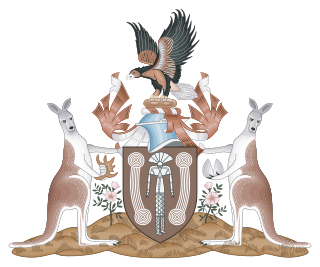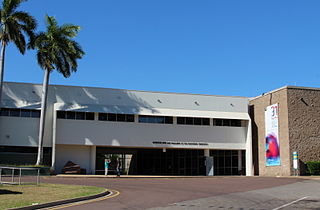See also
List of museums in Oceania | |
|---|---|
| Sovereign states | |
| Associated states of New Zealand | |
| Dependencies and other territories | |
This list of museums in the Australia contains lists of museums which are defined for this context as institutions (including nonprofit organizations, government entities, and private businesses) that collect and care for objects of cultural, artistic, scientific, or historical interest and make their collections or related exhibits available for public viewing. Also included are non-profit art galleries and university art galleries.

Australian art is any art made in or about Australia, or by Australians overseas, from prehistoric times to the present. This includes Aboriginal, Colonial, Landscape, Atelier, early-twentieth-century painters, print makers, photographers, and sculptors influenced by European modernism, Contemporary art. The visual arts have a long history in Australia, with evidence of Aboriginal art dating back at least 30,000 years. Australia has produced many notable artists of both Western and Indigenous Australian schools, including the late-19th-century Heidelberg School plein air painters, the Antipodeans, the Central Australian Hermannsburg School watercolourists, the Western Desert Art Movement and coeval examples of well-known High modernism and Postmodern art.

The Legislative Assembly of the Northern Territory is the unicameral legislature of the Northern Territory of Australia. The Legislative Assembly has 25 members, each elected in single-member electorates for four-year terms. The voting method for the Assembly is the full-preferential voting system, having previously been optional preferential voting. Elections are on the fourth Saturday in August of the fourth year after the previous election, but can be earlier in the event of a no confidence vote in the Government. The most recent election for the Legislative Assembly was the 2020 election held on 22 August 2020. The next election is scheduled for 24 August 2024.

The South Australian Museum is a natural history museum and research institution in Adelaide, South Australia, founded in 1856 and owned by the Government of South Australia. It occupies a complex of buildings on North Terrace in the cultural precinct of the Adelaide Parklands. Plans are under way to move much of its Australian Aboriginal cultural collection, into a new National Gallery for Aboriginal Art and Cultures.

Canberra Museum and Gallery is an art gallery and museum in Canberra, the capital of Australia. It is located on London Circuit, in Civic in the centre of the city. The gallery was opened on 13 February 1998.

John Mawurndjul is a highly regarded Australian contemporary Indigenous artist. He uses traditional motifs in innovative ways to express spiritual and cultural values, and is especially known for his distinctive and innovative creations based on a traditional cross-hatching style of bark painting technique known as rarrk.
Papunya Tula, registered as Papunya Tula Artists Pty Ltd, is an artist cooperative formed in 1972 in Papunya, Northern Territory, owned and operated by Aboriginal people from the Western Desert of Australia. The group is known for its innovative work with the Western Desert Art Movement, popularly referred to as "dot painting". Credited with bringing contemporary Aboriginal art to world attention, its artists inspired many other Australian Aboriginal artists and styles.
Anatjari Tjakamarra was a Central Australian Aboriginal artist who was part of the Papunya Tula art movement. He came from the area of Kulkuta, southeast of Kiwirrkura in Western Australia. He was a Pintupi man.
Kathleen Petyarre was an Australian Aboriginal artist. Her art refers directly to her country and her Dreamings. Petyarre's paintings have occasionally been compared to the works of American Abstract Expressionists Jackson Pollock and Mark Rothko, and even to those of J.M.W. Turner. She has won several awards and is considered one of the "most collectable artists in Australia". Her works are in great demand at auctions. Petyarre died on 24 November 2018, in Alice Springs, Australia.

The Museum and Art Gallery of the Northern Territory (MAGNT) is the main museum in the Northern Territory. The museum is located in the inner Darwin suburb of Fannie Bay. The MAGNT is governed by the Board of the Museum and Art Gallery of the Northern Territory and is supported by the Museums and Art Galleries of the Northern Territory Foundation. Each year the MAGNT presents both internally developed exhibitions and travelling exhibitions from around Australia. It is also the home of the annual Telstra National Aboriginal and Torres Strait Islander Art Award, Australia's longest-running set of awards for Indigenous Australian artists.
Wandjuk Djuwakan Marika OBE, was an Aboriginal Australian painter, actor, composer and Indigenous land rights activist. He was a member of the Rirratjingu clan of the Yolngu people of north-east Arnhem Land in the Northern Territory of Australia, and the son of Mawalan 1 Marika.

Makinti Napanangka was a Pintupi-speaking Indigenous Australian artist from Australia's Western Desert region. She was referred to posthumously as Kumentje. The term Kumentje was used instead of her personal name as it is customary among many indigenous communities not to refer to deceased people by their original given names for some time after their deaths. She lived in the communities of Haasts Bluff, Papunya, and later at Kintore, about 50 kilometres (31 mi) north-east of the Lake MacDonald region where she was born, on the border of the Northern Territory and Western Australia.
Danie Mellor is an Australian artist who was the winner of the 2009 National Aboriginal & Torres Strait Islander Art Award. Born in Mackay, Queensland, Mellor grew up in Scotland, Australia, and South Africa before undertaking tertiary studies at North Adelaide School of Art, the Australian National University (ANU) and Birmingham Institute of Art and Design. He then took up a post lecturing at Sydney College of the Arts. He works in different media including printmaking, drawing, painting, and sculpture. Considered a key figure in contemporary Indigenous Australian art, the dominant theme in Mellor's art is the relationship between Indigenous and non-Indigenous Australian cultures.
Tjunkiya Napaltjarri was a Pintupi-speaking Indigenous artist from Australia's Western Desert region. She is the sister of artist Wintjiya Napaltjarri.
Wintjiya Napaltjarri, and also known as Wintjia Napaltjarri No. 1, is a Pintupi-speaking Indigenous artist from Australia's Western Desert region. She is the sister of artist Tjunkiya Napaltjarri; both were wives of Toba Tjakamarra, with whom Wintjiya had five children.
Lucy Napaljarri Kennedy is a Walpiri and Anmatyerre-speaking Indigenous artist from Australia's Western Desert region. One of the first Indigenous women artists to paint in acrylics, her work has been exhibited at major galleries around Australia, and is held in the collection of the National Gallery of Victoria. She was made a Member of the Order of Australia in 1994 for services to the Yuendumu community.
Linda Yunkata Syddick Napaltjarri is a Pintupi- and Pitjantjatjara- speaking Indigenous artist from Australia's Western Desert region. Her father was killed when she was young; her mother later married Shorty Lungkarta Tjungarrayi, an artist whose work was a significant influence on Linda Syddick's painting.
Contemporary Indigenous Australian art is the modern art work produced by Indigenous Australians, that is, Aboriginal Australians and Torres Strait Islander people. It is generally regarded as beginning in 1971 with a painting movement that started at Papunya, northwest of Alice Springs, Northern Territory, involving Aboriginal artists such as Clifford Possum Tjapaltjarri and Kaapa Tjampitjinpa, and facilitated by white Australian teacher and art worker Geoffrey Bardon. The movement spawned widespread interest across rural and remote Aboriginal Australia in creating art, while contemporary Indigenous art of a different nature also emerged in urban centres; together they have become central to Australian art. Indigenous art centres have fostered the emergence of the contemporary art movement, and as of 2010 were estimated to represent over 5000 artists, mostly in Australia's north and west.
Tiger Palpatja was an Australian Aboriginal artist from the Aṉangu Pitjantjatjara Yankunytjatjara Lands.